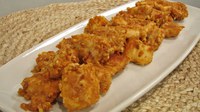Prairie Fare: Leftover Breakfast Cereal? Think Outside the Box
(Click the image below to view a high-resolution image that can be downloaded)
By Julie Garden-Robinson, Food and Nutrition Specialist
NDSU Extension Service
As I perused my cupboards and storage pantry the other day, I found several boxes of cereal. Some were unopened and some had folded-down wrappers with half of the contents waiting to be devoured.
Does this sound familiar to anyone?
I don’t think my family is alone in having some half-full cereal boxes in our cupboard. I admit I am tempted by the grocery store sales that offer multiple boxes of cereal for one low price.
Sometimes the sale on cereal does not require us to buy several boxes at one time. I need to remember this fact before I bring home five more boxes of cereal.
My kids, on occasion, still use their “pester power” to get me to buy some specialty cereal, too. Then they get tired of the cereal before the box is empty.
As I was studying the cereal supply in my cupboard, I looked at the “best if used by” dates on the boxes. Some dates were in the future and some dates were closing in on us.
If my family eats the cereal past the “best if used by” date, will I be rushing them to the emergency room? Will I be blaming myself for their illness because I provided old cereal that I didn’t have the heart to toss?
I won’t lose sleep about providing cereal beyond its quality date to my teenage and preteen children. If they were infants, however, and I was feeding them “baby cereal,” I would be using it by the date on the package.
Cereal is fairly shelf stable, but it can become stale and lose its appealing texture and flavor through time. If the cereal has an off odor or appearance or if the package has gotten damp, then I would toss it. As a rule of thumb, try to use opened cereal boxes within three months.
Be sure to write the date you purchased the cereal on the front of the box and arrange your stock in first-in-first out order. Better yet, put the cereal in airtight containers to extend its shelf life by reducing the cereal’s exposure to oxygen.
Breakfast cereal is one of the most convenient forms of nutrition. Breakfast cereals are portable, shelf-stable, economical and convenient. A child can fill a bowl with cereal and add some milk for an instant meal or snack.
In fact, breakfast cereals play a key role in helping children meet their vitamin and mineral needs, according to research. Most breakfast cereals are fortified with a wide range of vitamins and minerals.
Whole-grain cereals, in particular, are good sources of dietary fiber. Whole grain means that all parts of the grain, including the germ, endosperm and bran, are milled to produce the cereal.
How about the half-empty boxes of cereal in my cupboard and perhaps in yours? Don’t worry because we have plenty of ways to use cereal while saving money and reducing waste along the way. We just need to think outside the box a bit.
- Use leftover cereal as a bread crumb substitute. You do not need to buy breadcrumbs, and day-old bread is not your only option for a substitute. Try crushing unsweetened cereal varieties, such as corn or bran flakes, to use in place of breadcrumbs. Easily crush cereal by placing it in a plastic bag and crushing to the desired texture with a rolling pin. Use crushed cereal in meatloaf or to coat chicken breasts or French toast sticks. You can sprinkle 1/2 cup of crushed cereal on top of hash browns or a casserole.
- Stir cereal into pancake batter. Mix the pancake batter and then stir in some cereal. Cinnamon, chocolate, peanut butter or fruit-flavored cereals work well as additions to pancake batter. You can crush the cereal or leave it whole for bigger chunks. You also can mix cereal into waffle or muffin batter.
- Sprinkle cereal on yogurt, pudding or ice cream. If you’re looking for a little added crunch with yogurt, pudding or ice cream, try cereal. Instead of using granola, make a parfait by layering 1/2 cup of whole cereal with yogurt and cut-up fruit such as strawberries or peaches.
- Make a snack mix. Snack mixes can be a healthful, easy option to use extra cereal. Check out the “Make Your Own Snack Mixes” handout at http://www.ag.ndsu.edu/pubs/yf/foods/fn1753.pdf to learn more.
Here’s a delicious way to add nutrition and use up some cereal to make tasty homemade baked chicken nuggets.
Crunchy Chicken Nuggets
3 c. multigrain Cheerios cereal, crushed
1/2 c. Parmesan cheese, grated
1/2 tsp. salt
1/2 tsp. seasoned salt
1/4 tsp. paprika
1/8 tsp. garlic powder
3 Tbsp. butter or margarine, melted
1 Tbsp. milk
1 lb. boneless skinless chicken breasts (cut into 1- to 1 1/2-inch-square pieces)
Heat oven to 400 F. Line cookie sheet with foil. In medium bowl, stir together crushed cereal, cheese, salt, seasoned salt, paprika and garlic powder. In small bowl, stir together melted butter and milk. Dip chicken into butter mixture, then roll in cereal mixture to coat evenly. Place on cookie sheet. Bake nine minutes; turn nuggets over. Bake about eight minutes longer or until coating is light golden brown and chicken has reached 165 F.
Makes five servings (five chicken nuggets per serving). Each serving has 250 calories, 12 1/2 grams (g) of fat, 25 g of protein, 15 g of carbohydrate and 750 milligrams of sodium.
(Julie Garden-Robinson, Ph.D., R.D., L.R.D., is a North Dakota State University Extension Service food and nutrition specialist and professor in the Department of Health, Nutrition and Exercise Sciences.)
NDSU Agriculture Communication – May 7, 2015
| Source: | Julie Garden-Robinson, (701) 231-7187, julie.garden-robinson@ndsu.edu |
|---|---|
| Editor: | Rich Mattern, (701) 231-6136, richard.mattern@ndsu.edu |


